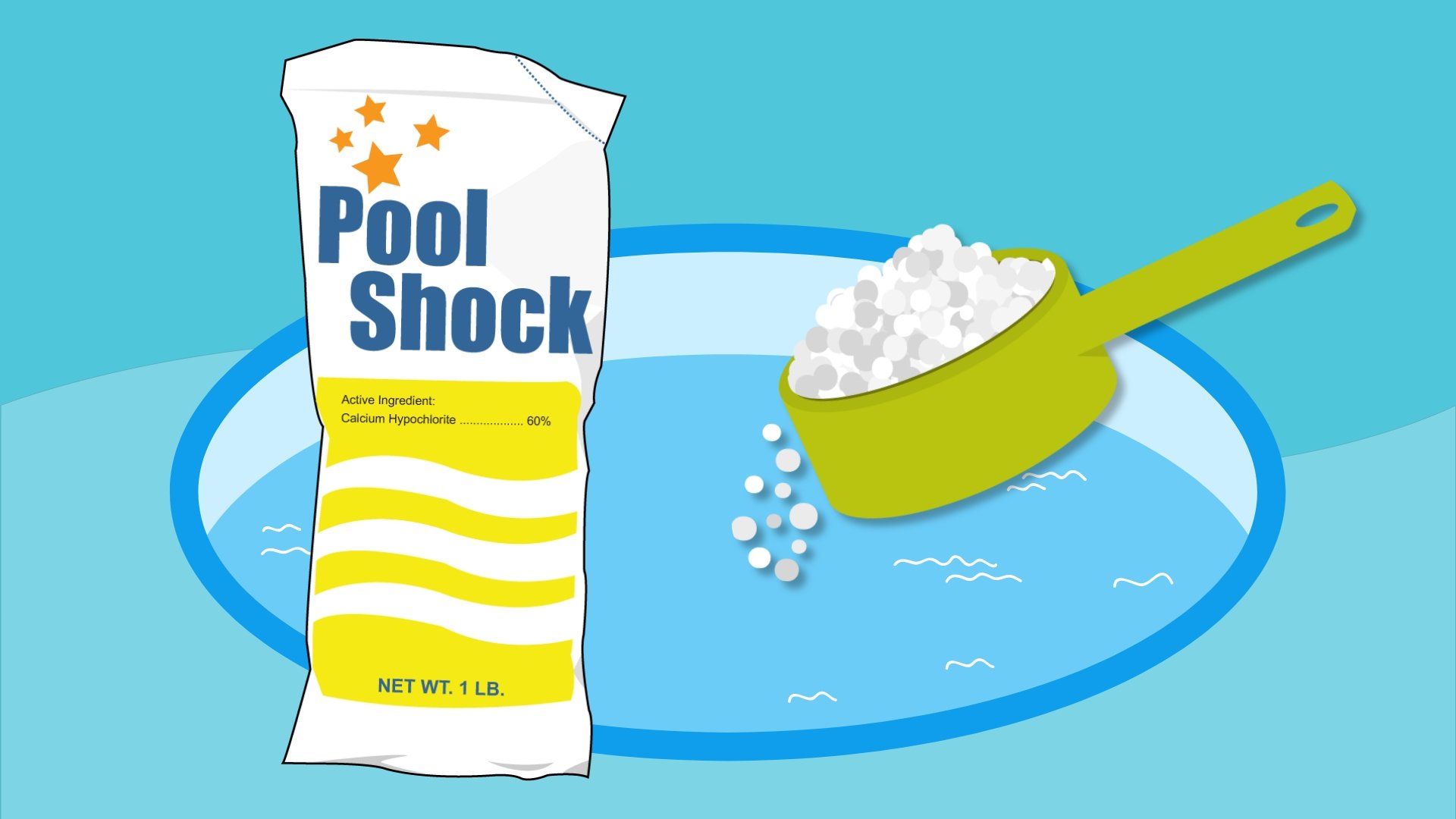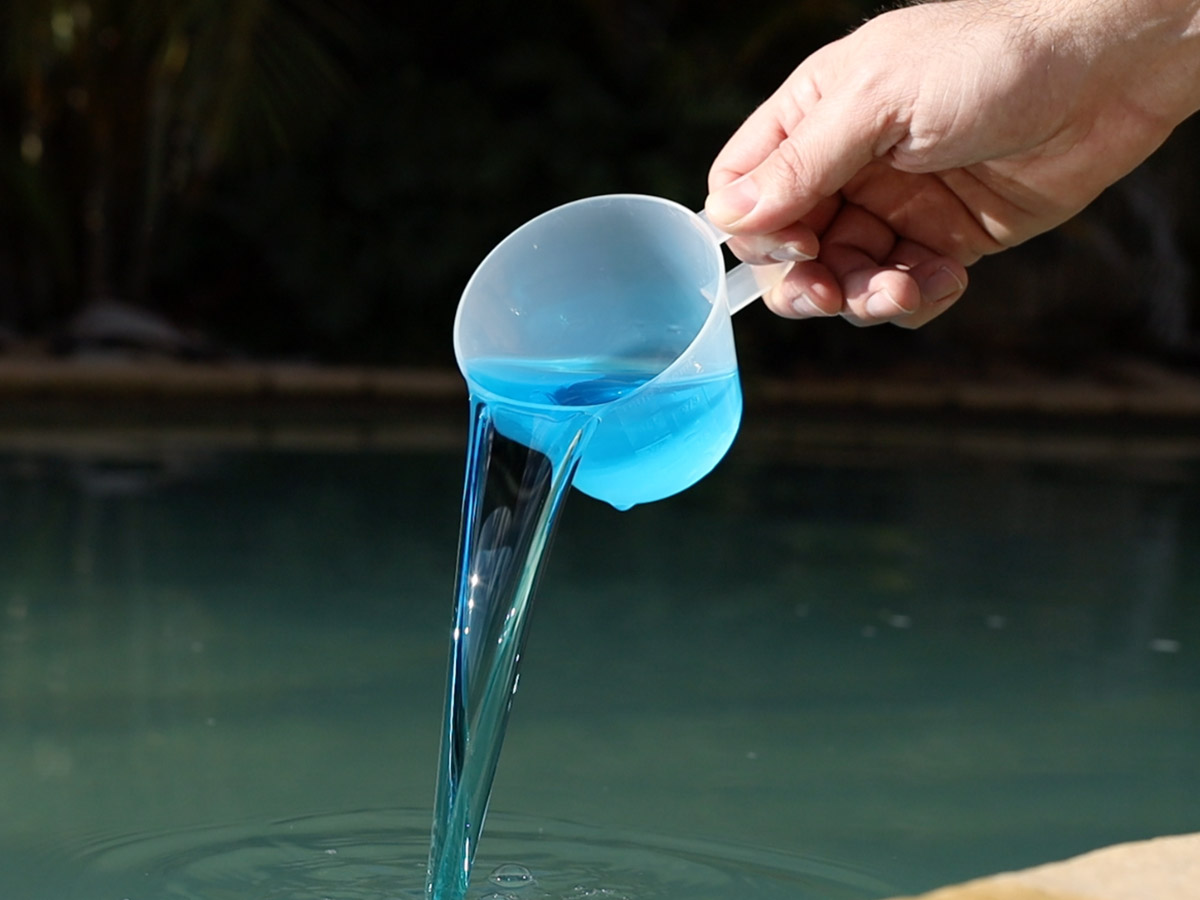Changing the Total alkalinity in the chemistry of your pool water is a slow process slower than any other chemical adjustment process that you will make if you own a swimming pool inground or aboveground the one thing I learned after 30 years of owning an inground pool. Never add chemicals too close together. Can I add Alkalinity, and Shock at the Same Time?
No, Never add chemicals at the same time, whether you’re balancing the H2O, shocking the pool, or adding a specialty chemical. For most H2O balance changes, the pump needs to run for at least 4 hrs, or long enough for the pump to turn over the pool before you can add shock chlorine or retest the H2O.
Follow these directions for adding chemicals to your swimming pool whether it’s inground or small aboveground patience is needed especially when you balancing alkalinity readings that are too low or too high.
Introduction:
When adding pool chemicals to your swimming pool, it’s important to avoid adding certain chemicals with others that may have negative reactions in the pool. You can avoid chemical conflicts by following instructions on each product to see when and how they can be introduced to the pool, as well as how long to wait before swimming or adding additional chemicals to the water.
Make sure the pump is running at high speed during and between chemical additions, which will help disperse the product throughout the pool. You should also add chemicals in different areas of the pool to help prevent adverse reactions. Below, you’ll find a list of some incompatible pool chemical combinations that should never be mixed.
Can I Add Alkalinity and Shock at the Same Time
Managing your pool’s water chemistry is crucial for maintaining a safe and enjoyable swimming environment. One common question pool owners have is: Can I add alkalinity and shock at the same time? While total alkalinity and pool shock are essential for pool care, it’s important to understand how adding chemicals affects your water balance. Generally, you should never add chemicals at the same time. That said, yes, it is safe to add at the same time under certain conditions, but context matters.

When it comes to adding pool chemicals, always read the manufacturer’s guidelines for your spa equipment and spa chemicals. Improper mixing can damage hot tub and pool surfaces and affect the water’s chemical composition. For example, shock can temporarily reduce alkalinity levels, potentially causing unwanted reactions. Thus, it’s generally recommended to adjust the total alkalinity first, wait for the water to stabilize, and then proceed with pool shock.
Understanding the precise order of adding chemicals is part of the crucial tips pool owners should follow for optimal pool care. Properly managing water balance ensures a longer lifespan for your spa equipment and better water quality in your hot tub or pool. For more advice on the orderly addition of pool chemicals, trust MyWaterEarth&Sky’s expertise in pool care and chemical management.
*For a square or rectangle-shaped pool, the formula is length x width x Average depth = volume x 7.5 gals. (in a cubic foot) will give you how many gallons your pool holds.
A 1.5 HP pump would give you a flow rate of approximately 90 gallons per minute which would circulate this pool just fine
if you run the pool 8 hours per day, you need to “turn over” the water once per day. If you take 24,000 gallons divided by 8 hours, that means you need to circulate 3000 gallons per hour or 50 gallons per minute.
So a pool that is 20 ft. long and 18 ft. wide and has an average depth of 6 ft = 2160 cu ft. x 7.5 = 16,200 gallons in your pool. If your 1.5 hp pool pump pulls approximately 90 gals/per minute 16,200 divided by 90 =180/60 mins in an hour 3+ hours.
In about 3 hours your pool is turned over which means any chemical added to your swimming pool is mixed between 3 and 4 hrs. You should wait around 4 hours to retest Alkalinity before moving forward. If this doesn’t make sense to you use a Pool Volume Calculator
How Long Do You Wait Between Adding Pool Chemicals?
All pool chemicals take their own time to mix and dissolve when added to pool water then changing the chemistry of the pool water but it all depends on the chemical’s active ingredients or strength the volume of your pool, and how much change is needed ………………………………………………… Read more
Bad Water Balance Combinations in Your Pool
Maintaining a well-balanced pool is vital for ensuring clear, safe water, but bad water balance combinations in your pool can cause many issues. For example, adding alkalinity and shock at the same time is a common mistake.
Bad pool chemical combinations to avoid can lead to cloudy water, damaged spa equipment, and ineffective pool shocking. When adding chemicals, especially spa chemicals in hot tubs, it’s crucial to follow proper guidelines. Some tips pool owners should follow include never adding pool chemicals simultaneously. Alkalinity levels can drastically change when the wrong chemicals are mixed. Pool care requires attention to details like water balance, which is delicate and can be disrupted easily.
The key is adding pool chemicals in the correct order to avoid bad water balance. Pool shocking should be done separately from adjusting alkalinity to ensure optimal results. A well-maintained water balance protects your investment in spa equipment and ensures a pleasant swimming experience. Always pay attention to bad pool chemical combinations to avoid so your pool remains in top shape. Remember, adding pool chemicals one at a time is the best practice. At MyWaterEarth&Sky, we emphasize the importance of proper chemical management, focusing on the interaction between spa chemicals and overall pool care.
Understanding Pool Water Chemistry: pH and Alkalinity
When it comes to maintaining a pristine ground pool, understanding pool water chemistry is crucial. pH levels and total alkalinity are the key elements to focus on. Properly managing these two aspects ensures your pool chemicals work effectively.
pH levels in-ground pools should ideally range between 7.2 and 7.6, ensuring comfort for swimmers and the efficiency of pool chemicals. Total alkalinity acts as a buffer, stabilizing pH levels and protecting against drastic fluctuations. Ground pools often require a balance of these elements to maintain optimal water quality. Pool pumps and pool cleaners also play a significant role in circulating pool chemicals, ensuring they’re evenly distributed.
Chlorine shock is a common treatment used for eliminating contaminants. When you’re shocking your pool, it’s essential to monitor both pH levels and total alkalinity to prevent imbalances. Shocking and adding alkalinity might seem like a shortcut, but it can lead to chemical conflicts, disrupting overall pool water chemistry. Tips on the proper sequence are vital; always measure and adjust total alkalinity first, then proceed with shocking. MyWaterEarth&Sky recommends regular testing and balancing of pH levels and total alkalinity to avoid complications. Proper pool water chemistry management with the right pool chemicals will keep your pool inviting and safe.

The Role of Pool pH Levels in Water Chemistry
Understanding the role of pool pH levels in water chemistry is crucial for effective pool care. Pool chemicals interact with each other and with the water in your ground pool, and maintaining the right pH levels ensures that these interactions benefit your pool’s condition. High or low pH levels can make your ground pool less comfortable and may even damage pool equipment like pool pumps.
The total alkalinity acts as a buffer for these pH levels, stabilizing them and preventing dramatic swings that can affect the effectiveness of chlorine shock and other pool chemicals. When pool chemicals are added, it’s essential to monitor the pH to ensure that they work as intended. Pool cleaners and other maintenance tools are more effective when pH levels are correct, keeping your pool sparkling and safe. Total alkalinity is vital in this balancing act, providing the stability that supports optimal chlorine shock performance.
MyWaterEarth&Sky understands the significance of pH balance in water chemistry, offering tips to help you manage it effectively. With the right pool care, you’ll protect your pool’s surface and equipment, ensuring longevity and enjoyment. Proper use of pool chemicals, guided by balanced pH levels, guarantees a cleaner, clearer swimming experience.
The Effects of Adding Alkalinity and Shock Pool Chemicals
When it comes to pool care, understanding the effects of adding alkalinity and shock pool chemicals at the same time is crucial for maintaining a pristine swimming environment. Pool chemicals, particularly those aimed at altering pH levels and total alkalinity, play an integral role in water balance. Shock pool chemicals, commonly referred to simply as “shock,” are used to quickly sanitize and clean ground pools.
However, the effects of adding alkalinity and shock at the same time can be detrimental. The interaction between shock pool chemicals and alkalinity can cause a cloudy or uneven water balance, which can affect the pool’s pH levels. Improper timing could compromise the efficiency of your pool pumps and lessen the intended effects of these pool chemicals. For optimal ground pool maintenance, it’s advisable to add these chemicals separately.
First, stabilize the total alkalinity before you proceed with pool shocking. Following this orderly addition will ensure that each pool chemical works effectively. Without proper management, adding pool chemicals at the same time can result in unstable water balance and ineffective sanitation. Always check with a trusted resource like MyWaterEarth&Sky for expert advice on the effects of adding alkalinity and shock pool chemicals to keep your pool in top condition.
Best Practice Pool Chemical Tips for Proper Addition
Keeping your pool water in pristine condition is no small feat, which is why following best practice pool chemical tips is crucial for pool care. When adding chemicals, it’s essential to understand the proper addition sequence to maintain balanced water chemistry.
For example, adding pool chemicals like alkalinity increasers and shocking agents is a task that should be done with caution. It’s vital to first test for alkalinity levels and then proceed with shocking your pool if needed. Improper chemical addition can lead to a myriad of issues, including poor water quality and potential damage to your pool pumps. Whether you’re managing above-ground pools or in-ground pools, the order in which you add pool chemicals significantly impacts their effectiveness. Always ensure your pool pumps are running to help circulate and evenly distribute the chemicals.
Shocking your pool helps to eliminate harmful contaminants but should be done after adjusting any alkalinity levels to prevent adverse chemical reactions. By adhering to these best practice pool chemical tips, you can ensure a safe and clean swimming environment. Remember, understanding the proper addition of pool chemicals isn’t just for pool maintenance; it’s also a cornerstone in extending the life of your pool and its accessories.
Cheat Sheet for adding Chemicals:
In What Order Do I Add Pool Chemicals
In What Order Do I Add Chemicals to My Pool?
- Alkalinity(80-140 ppm) wait time 4-8 hrs.
- Retest TA
- pH (7.2 -7.6 ) wait time 30 min.
- Retest pH
- Calcium Hardness-(200–400 ppm) wait time-30 min.
- Cyanuric Acid-(25-50 ppm) wait time 30 min.
- Shock the Pool-10 ppm wait time -4 hrs.
- Algaecide after shock wait time-5 days ……………………………………….. Read more

References:
HyChl- In What Order Do I Add Pool Chemical
FAQ’s
- How do I shock my pool, and how often should I do it? Shocking involves adding a concentrated dose of chlorine or non-chlorine shock to oxidize organic contaminants. Shock weekly or after heavy use, following product instructions.
- Q: What is cyanuric acid (stabilizer), and why do I need it? Cyanuric acid helps stabilize chlorine from UV degradation in outdoor pools. Add as needed to maintain levels between 30-50 ppm, but avoid excessive buildup.
- Q: How do I prevent and treat algae growth? Regularly maintain proper sanitizer levels and circulation, brush pool surfaces, and shock weekly. Use algaecides for prevention or treatment, following product instructions.
- Q: How do I store pool chemicals safely? Store pool chemicals in a cool, dry, well-ventilated area away from sunlight, moisture, and incompatible substances. Keep them tightly sealed in their original containers and out of reach of children and pets.
- Q: What should I do if I accidentally spill or mix pool chemicals improperly? Immediately rinse affected areas with water, ventilate the area, and follow emergency instructions on the chemical label. If unsure, contact a pool professional or poison control center for guidance.

